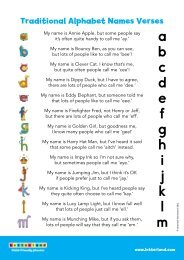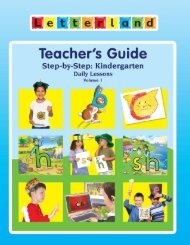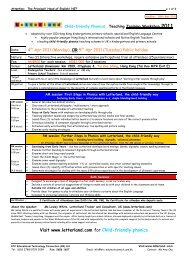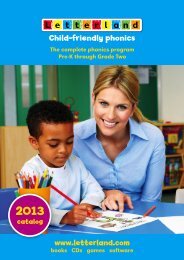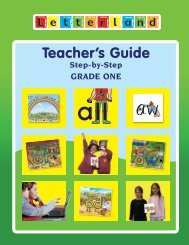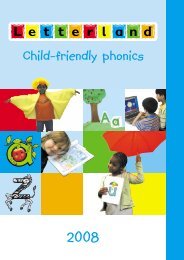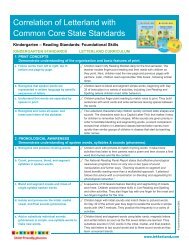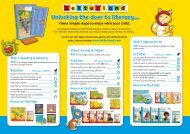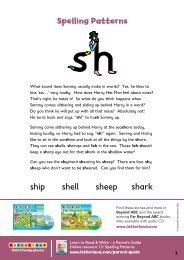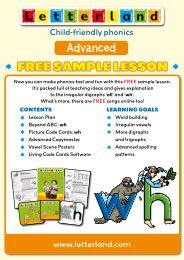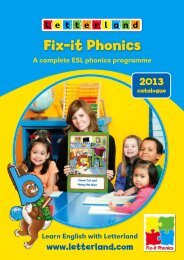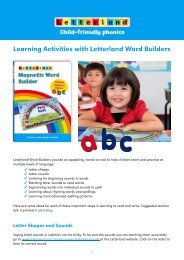Academic Recognition of Letterland
Academic Recognition of Letterland
Academic Recognition of Letterland
You also want an ePaper? Increase the reach of your titles
YUMPU automatically turns print PDFs into web optimized ePapers that Google loves.
to help children connect the shape <strong>of</strong> the letter to its sound. Research shows that this makes iteasier for the children to learn the correspondences (Ehri, Deffer, & Wilce, 1984)”5) Lesley Morrow, Robert Rueda & Diane Lapp, Handbook <strong>of</strong> Research on Literacy andDiversity: Issues Concerning Social Justice, ELL, and Policy, 2010, Guilford Publications. Chapter byDr Linnea Ehri on mnemonics, including illustrations <strong>of</strong> <strong>Letterland</strong> embedded mnemonics andevaluative comments on their relevance for English Language Learners.6) DR DENNIS MOLFESE Ph.D., Distinguished University Scholar, Chair & Pr<strong>of</strong>essor, Department <strong>of</strong>Psychological and Brain Sciences, University <strong>of</strong> Louisville, Kentucky, Editor-in-Chief <strong>of</strong> DevelopmentalNeuropsychology:"Very clearly, <strong>Letterland</strong> <strong>of</strong>fers a systematic program <strong>of</strong> instruction for alphabetic and phonologicalknowledge that is critical for the early stages <strong>of</strong> reading development. The materials are welldesigned and highly attractive to children, serving to motivate them to spend more and more timelearning to recognize and name the letters <strong>of</strong> the alphabet as well as learn the letter sounds ANDdevelop their rhyming and rime skills. Researchers across the world have repeatedly found thatthese components are the literal building blocks that lead to reading success."7) REBECCA H. FELTON Ph.D. Reading Consultant, Author, Dyslexia Researcher and formerFaculty member, Neuropsychology Department, Bowman Gray School <strong>of</strong> Medicine:"Many children who are at risk for reading difficulties have serious problems learning the namesand sounds for the letters <strong>of</strong> the alphabet. <strong>Letterland</strong>, with its engaging characters, stories, songs,gestures for each letter, provides a rich and effective system <strong>of</strong> cues for letter-soundassociations. Use <strong>of</strong> these multiple cues as part <strong>of</strong> the <strong>Letterland</strong> reading program should ensurethat all students develop mastery in this critical component <strong>of</strong> reading."8) BOB SCHLAGAL Ph.D., Pr<strong>of</strong>essor <strong>of</strong> Reading, Graduate Faculty and Senior Clinician,Department <strong>of</strong> Language, Reading, & Exceptionalities Appalachian State University USA, BoardMember, North Carolina Branch <strong>of</strong> the International Dyslexia Association:“<strong>Letterland</strong> is the most effective <strong>of</strong> all the synthetic phonics programs for children that I haveobserved or worked with. This program is not only extremely well-thought out, it is highlyimaginative and distinctly and usefully memorable. As a result, teachers and children alike takepleasure in carefully exploring the terrain in which letters and groups <strong>of</strong> letters live and interact.As a long term student <strong>of</strong> young children’s writing and spelling development, I have beensingularly impressed at the early start that children get with the aid <strong>of</strong> <strong>Letterland</strong> instruction. (Thisis something that teachers comment on with regularity.) I have consistently observed earlier, moreaccurate and more complete phonemic analysis in children’s spelling under this system —<strong>Letterland</strong>’s dramatic “live spelling” may be a powerful help in this--as well as a willingness to writeamong even the most shy and least secure children. Although I have focused my comments onchildren’s writing, I see the same kind <strong>of</strong> excitement and progress in their reading”.9) LUANNE MCFARLANE, MSc, Associate Pr<strong>of</strong>essor, Speech Pathology & Audiology, University <strong>of</strong>Alberta, Edmonton, Canada (extracts from the Journal <strong>of</strong> Speech-Language Pathology andAudiology Vol 22, No. 4, Dec 1998):“<strong>Letterland</strong> is a comprehensive teaching system designed to increase reading success … for usewith children ages three to seven plus… All aspects <strong>of</strong> reading are taught through metaphors,stories, … songs, … narrative and natural experience... The materials are economical and have amultitude <strong>of</strong> uses... <strong>Letterland</strong> is a structured, exciting method for introducing early literacy skillsand continuing the instruction through the early school years...2
There is immense potential for integration into individual and group intervention for phonemicawareness, articulation, phonology, and expressive language... A high degree <strong>of</strong> structure makesit appropriate for use by speech-language pathology assistants and families... The wide range <strong>of</strong>materials saves time in developing activities for use in the home or by aides and assistants… Iwould highly recommend the use <strong>of</strong> the materials.”3



